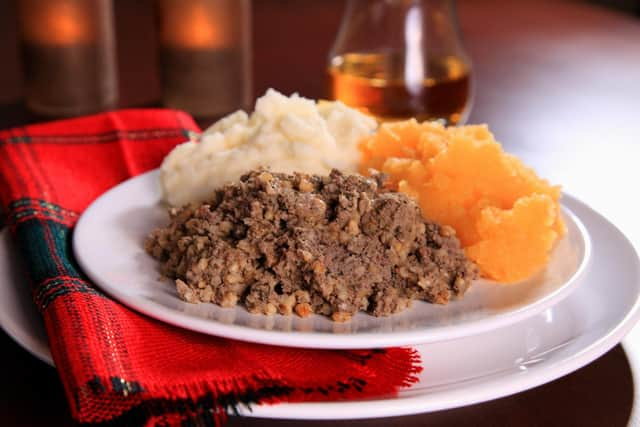What is Haggis made of? Is it Scottish? Why is it banned in the US? Recipe & history of Burns Night dish
Haggis is enjoyed by many Scots as they celebrate the life of famous Scottish poet Robert Burns on Burns Night, but what is haggis made of and why is it banned in the US?
Despite being a famous Scottish dish considered ‘awfie’ delicious by many, the history of haggis is somewhat mysterious and it has a contested history. It was popularised by Scottish poet Robert Burns in the 18th century when he referred to it as that ‘great chieftain o' the puddin-race’ and to this day the dish is still enjoyed by Scots around the world on January 25 for Burns Night.
However, its legacy as a Scottish phenomena much like Irn Bru or whisky may not be accurate as the dish has a complicated history.


What is Haggis made of?
Advertisement
Hide AdAdvertisement
Hide AdHaggis (known as ‘tagais’ in Scottish Gaelic) is a dish made from the liver, stomach or heart of sheep or cows. Whatever meat is used is usually mixed with onion, oatmeal and suet before being boiled in the animal’s stomach.
Traditionally, the meat is then served with a turnip and potato mash that is famously known in Scotland as ‘neeps and tatties’.
Why is Haggis banned in the USA?
If you’re in the US then you won’t be able to buy a traditional haggis as it has been banned in the country since the 1970s. It became illegal to import haggis from Scotland in 1971 as there was a sanction on food containing Sheep lungs which constitutes a large portion of the traditional Haggis recipe.
According to a report by iNews it’s known that Americans “can’t even make their own haggis as US-produced foods containing sheep lungs are also prohibited.” Joelle Hayden who works for the US Department of Agriculture, the Food Safety and Inspection Service, confirmed that the ban exists as they “determine sheep lungs to be inedible and, therefore, cannot be utilised for human consumption.”


Where does Haggis come from?
Despite being considered the quintessential Scottish dish, there are no clear origins for Haggis as many similar recipes appear across world cultures with some historical evidence pointing to it not originating from Scotland at all. Ancient Romans, for example, made haggis-type dishes that also stuffed offal inside animals’ stomachs.
Within the context of Scotland, however, Historic UK reports that the dish may originate from when old Scottish cattle drovers would leave the Highlands to journey to the cattle market in Edinburgh with Haggis being the meal that sustained them on that journey.
Others point to other Scottish ancestors like Vikings who may have imported Haggis to Scotland following their invasion in the late 8th century.
Some even say it may have originated in England. In 2013 a food historian claimed haggis is an English dish, whose Scottish origins are as “made up” as tartan. Peter Brears, 68, said that many traditional tartans were “invented”, claiming that haggis and tartan were both appropriated by Scots in order to revitalise the country’s national identity. “Haggis is a really good English dish,” said Brears, the author of Traditional Food In Northumbria. The earliest recipes are from 1390 from a book called The Forme of Cury, which means ‘the art of cooking’."
Comments
Want to join the conversation? Please or to comment on this article.